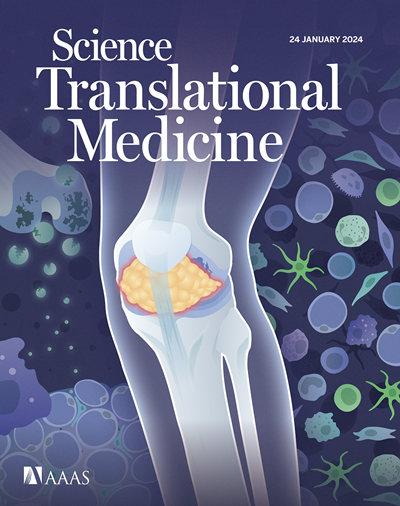重复接种基于 COVID-19 mRNA 的疫苗可促进粘膜中的 SARS-CoV-2 中和抗体反应
IF 14.6
1区 医学
Q1 CELL BIOLOGY
引用次数: 0
摘要
为了预防呼吸道病毒感染并限制病毒传播,疫苗需要促进粘膜免疫。目前使用的基于信使 RNA (mRNA) 的 COVID-19 疫苗能在多大程度上诱导粘膜免疫,目前还不清楚。我们评估了一组 183 人的粘膜中和抗体反应。在接种基于腺病毒载体或基于 mRNA 的 COVID-19 疫苗初免和基于 mRNA 的加强免疫后,我们在多个时间点对参与者进行了采样。我们的研究结果表明,重复接种 mRNA 强化疫苗可促进鼻腔分泌物中的严重急性呼吸系统综合征冠状病毒 2(SARS-CoV-2)中和抗体。鼻腔和血清中的 IgG 和 IgA 型中和抗体滴度相互关联。我们在一个小鼠模型中研究了这些粘膜抗体的来源,该模型中的小鼠重复接种了 SARS-CoV-2 mRNA 疫苗。这些实验表明,产生中和抗体的细胞存在于脾脏和骨髓中,而尽管检测到了粘膜抗体,却没有观察到组织归巢到呼吸道粘膜的证据。血清转移实验证实,循环抗体能够迁移到呼吸道粘膜。总之,这些结果表明,目前使用的 COVID-19 mRNA 疫苗可以激发粘膜中和抗体,尤其是在重复接种的情况下,而且接种疫苗还可能刺激以前 SARS-CoV-2 感染诱导的粘膜免疫。此外,循环抗体迁移到呼吸道粘膜可能是一个主要机制。这些发现加深了我们对 mRNA 疫苗诱导免疫的理解,对设计抗呼吸道感染的疫苗策略具有重要意义。本文章由计算机程序翻译,如有差异,请以英文原文为准。
Repeated COVID-19 mRNA-based vaccination contributes to SARS-CoV-2 neutralizing antibody responses in the mucosa
To prevent infection by respiratory viruses and consequently limit virus circulation, vaccines need to promote mucosal immunity. The extent to which the currently used messenger RNA (mRNA)–based COVID-19 vaccines induce mucosal immunity remains poorly characterized. We evaluated mucosal neutralizing antibody responses in a cohort of 183 individuals. Participants were sampled at several time points after primary adenovirus vector–based or mRNA-based COVID-19 vaccination and after mRNA-based booster vaccinations. Our findings revealed that repeated vaccination with mRNA boosters promoted severe acute respiratory syndrome coronavirus 2 (SARS-CoV-2) neutralizing antibodies in nasal secretions. Nasal and serum neutralizing antibody titers of both IgG and IgA isotypes correlated to one another. We investigated the source of these mucosal antibodies in a mouse model wherein mice received repeated mRNA vaccines for SARS-CoV-2. These experiments indicated that neutralizing antibody–producing cells reside in the spleen and bone marrow, whereas no proof of tissue homing to the respiratory mucosa was observed, despite the detection of mucosal antibodies. Serum transfer experiments confirmed that circulating antibodies were able to migrate to the respiratory mucosa. Collectively, these results demonstrate that, especially upon repeated vaccination, the currently used COVID-19 mRNA vaccines can elicit mucosal neutralizing antibodies and that vaccination might also stimulate mucosal immunity induced by previous SARS-CoV-2 infection. Moreover, migration of circulating antibodies to the respiratory mucosa might be a main mechanism. These findings advance our understanding of mRNA vaccine–induced immunity and have implications for the design of vaccine strategies to combat respiratory infections.
求助全文
通过发布文献求助,成功后即可免费获取论文全文。
去求助
来源期刊

Science Translational Medicine
CELL BIOLOGY-MEDICINE, RESEARCH & EXPERIMENTAL
CiteScore
26.70
自引率
1.20%
发文量
309
审稿时长
1.7 months
期刊介绍:
Science Translational Medicine is an online journal that focuses on publishing research at the intersection of science, engineering, and medicine. The goal of the journal is to promote human health by providing a platform for researchers from various disciplines to communicate their latest advancements in biomedical, translational, and clinical research.
The journal aims to address the slow translation of scientific knowledge into effective treatments and health measures. It publishes articles that fill the knowledge gaps between preclinical research and medical applications, with a focus on accelerating the translation of knowledge into new ways of preventing, diagnosing, and treating human diseases.
The scope of Science Translational Medicine includes various areas such as cardiovascular disease, immunology/vaccines, metabolism/diabetes/obesity, neuroscience/neurology/psychiatry, cancer, infectious diseases, policy, behavior, bioengineering, chemical genomics/drug discovery, imaging, applied physical sciences, medical nanotechnology, drug delivery, biomarkers, gene therapy/regenerative medicine, toxicology and pharmacokinetics, data mining, cell culture, animal and human studies, medical informatics, and other interdisciplinary approaches to medicine.
The target audience of the journal includes researchers and management in academia, government, and the biotechnology and pharmaceutical industries. It is also relevant to physician scientists, regulators, policy makers, investors, business developers, and funding agencies.
 求助内容:
求助内容: 应助结果提醒方式:
应助结果提醒方式:


